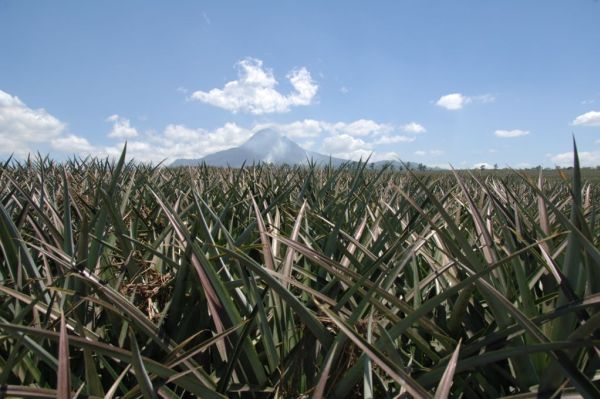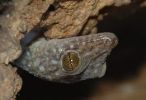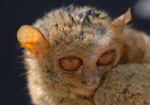Filipino environmentalists and religious leaders have expressed shock and anger that Gloria Macapagal-Arroyo, the President of the Philippines, has been chosen to receive a conservation award from the US Congress in Washington, DC today according to the Philippine Daily Enquirer.
“Honoring President Gloria Macapagal-Arroyo as a conservationist and protector of biodiversity is akin to giving a fox an award for chicken husbandry,” read a letter signed by Filipino religious leaders. “President Arroyo has led a deeply corrupt regime that has promoted and profited from environmental despoilation by mining, logging, overfishing and the promotion of unsustainable plantation production.”
The Teddy Roosevelt International Conservation Award, named after the US’s legendary conservation president, is given to leaders for innovative conservation policies by the International Conservation Caucus Foundation (ICCF) and the Global Environment Facility (GEF). The award is seen by many as a response to Macapagal-Arroyo’s work on the conservation of the Coral Triangle region. Covering six countries and 6 million square kilometers (half the size of the US), the Coral Triangle is home to 500 coral species, 5 of 7 of the world’s marine turtle, and some 3,000 described fish. Last year the six Coral Triangle nations reached a non-binding agreement to protect the area.
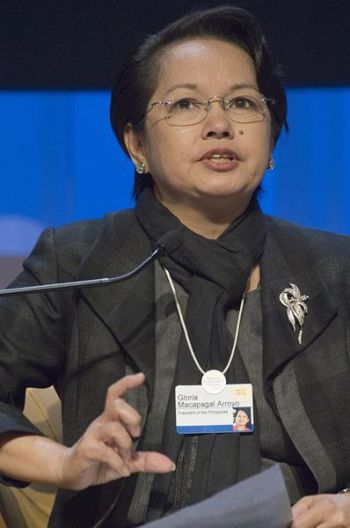 President of the Philippines, Gloria Macapagal-Arroy, at the World Economic Forum in Davos, Switzerland in 2007. Today, the president recieves The Teddy Roosevelt International Conservation Award in the US. A reward, both local and international environmentalists, say she doesn’t deserve. Photo courtesy of the World Economic Forum. |
Yet, Clive Montgomery Wicks, consultant of the Commission on Environmental, Economic and Social Policy at the IUCN, raised several concerns to the ICCF and GEF in a recent letter about President Macapagal-Arroyo environmental record.
President Macapagal-Arroyo is “pushing for a massive expansion of mining even in key protected areas like Mount Guiting-Guiting on Sibuyan Island (The Galapagos of Asia) where a former WWF-Philippines colleague of mine, and a Philippine Municipal Councilor, was murdered by a mine company guard in 2007,” Wicks wrote according to the Philippine Daily Enquirer, adding that “the Protected Seascape in Pujada Bay and Mt. Hamiguitan Range, a declared protected area in Davao del Sur, Mindanao, is another case in point where mining tenements have been allowed.”
Wicks, who said that Teddy Roosevelt would “turn in his grave” over giving the award to President Macapagal-Arroyo, added that, “we are also concerned with other mining plans, including the important central Mt. Sugarloaf range in the Zamboanga Peninsula.”
From 1990-2005 the Philippines lost a third of its forest cover. Macapagal-Arroyo has been president since 2001, having served as Vice President since 1998. Forest loss has declined recently to around 2 percent a year, largely due to the fact that the Philippines has little forest left to lose.
Local environment organization, the Kalikasan People’s Network for the Environment (Kalikasan-PNE), has also come out against the president receiving the award, citing 27 cases of extrajudicial killings of grass-roots environmental leaders fighting against dams, logging, and mining operations in the Philippines.
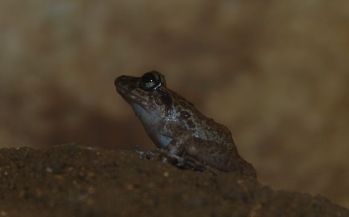 The Critically Endangered Gigante island frog (Platymantis insulatus) is endemic to two small islands in the Philippines. Photo by: Pierre Fidenci, the founder and president of Endangered Species International. |
Clemente Bautista, national coordinator of Kalikasan-PNE, further criticized the award itself, telling the Philippine Daily Enquirer that “considering the composition and the thrust of the ICCF and GEF, it is understandable that they chose to honor Ms Arroyo as she has been very loyal to their corporate interests of the members of the said organizations.”
For example, the Conservation Council of the ICCF includes a number of big corporations with questionable environmental records: ExxonMobil, International Paper, Unilever, 3M, the American Petroleum Institute, and Ringling Brothers and Barnum and Bailey Circus. ICCF’s advisory council is made up of WWF, the Nature Conservancy, Conservation International, and the Wildlife Conservation Society.
Other local environmental groups that have come out publically against President Macapagal-Arroyo receiving the award including Green Convergence for Safe Food, Healthy Environment and Sustainable Freedom.
In response to the criticism, Gary Olivar the spokesperson for President Macapagal-Arroyo said: “As for those [opposing the award], who are likely motivated by their own murky ideological agendas, we’d only be too happy to line up the President’s green credentials against theirs.”
Considered a global biodiversity hotspot, the Philippines is home to some 9,000 plants, 160 mammals, over 300 reptiles and amphibians, and over 500 birds. Endemic rates of species, meaning they survive no-where else, range from 23 percent (freshwater fish) to 85 percent (amphibians). Population growth, poverty, extractive industries, and corruption leads many scientists to fear that many Filipino species will vanish in upcoming decades.
President Gloria Macapagal-Arroyo has become largely unpopular in the Philippines near the end of her final term: in a new poll 69 percent say they are dissatisfied with the president’s performance, while16 percent say they are satisfied.
Past winners of the Teddy Roosevelt International Conservation Award include Tony Blair and Prince Albert II of Monaco.
Little forest remains in the Philippines. In this photo, rainforest was replaced by vast plantations of pineapples by Dole corporation in the Philippines. Photo by: Pierre Fidenci, the founder and president of Endangered Species International.
Related articles
Forgotten species: the subterranean Gekko gigante
(04/08/2010) Travelers to tropical destinations are likely familiar with the gecko. Clinging to walls and ceilings of buildings—sometimes staring down at you from the bedroom ceiling or glancing at you quizzically from the bathroom door—the small adhesive-footed lizard could be aptly described in some tropical areas as ubiquitous. Despite the apparent commonness of some species, geckos are delightful lizards with round wide eyes, a thick gripping tongue, and of course that amazing knack of seemingly defying gravity with specialized toe pads. But not all geckos are as easily found—or as common—as those hanging out, literally, in a jungle lodge. The Gekko gigante, also known as the Gigante narrow-disked gecko, has been little- noticed by the public. Even scientists know little about the lovely gray-and-blue gecko beyond the fact that it lays its eggs on cool moist cave walls in two Philippine Islands.
Photo: Fruit-eating dragon discovered in the Philippines
(04/07/2010) Scientists have discovered a new species of giant lizard in the unlikeliest of places: a highly populated, deforested landscape in the Philippines.
(03/18/2010) The United Nation declared 2010 as the International Year of Biodiversity (IYB). One of the goals of the IYB is to celebrate the achievements of the Convention of Biological Diversity signed by 192 countries since 1992. But what have we accomplished since 1992? Did we put an end to biodiversity loss? The truth is that there is not much to celebrate at all. Asia is a perfect example where the animal crisis and the loss of biodiversity have worsened over decades. The first question that should come to mind is: how many species have vanished in Asia because of human activities? Records of recently extinct species in Asia show 71 species that have disappeared in the wild. Examples include the Yunnan lake newt (Cynops wolterstorffi) from China, the Bonin thrush (Zoothera terrestris) from Japan, or the redtailed black shark (Epalzeorhynchos bicolor) from Thailand.
Malaysian palm oil firms seek 100,000 ha in the Philippines
(06/08/2009) Malaysian oil palm developers are looking to establish a a 100,000-hectare palm oil plantation and extraction facility on the island of Mindanao in the Philippines, reports Business Mirror, a Philippine business publication.
Six nations pledge to protect the Coral Triangle
(05/19/2009) Last Friday, six nations signed a pledge launching the Coral Triangle Initiative on Coral Reefs, Fisheries and Food Security (CTI-CFF). Indonesia, the Philippines, Timor Leste, Papua New Guinea, Solomon Islands, and Malaysia each agreed to protect the Coral Triangle, a region spanning 1.6 billion acres, half the size of the US.
Will the illegal trade of the critically endangered Philippine forest turtle lead to its extinction?

(05/04/2009) Endangered Species International (ESI) conducted ongoing monitoring at markets known to sell pets and wild animals in Manila, Philippines, to monitor the status of the trade of one of the most endangered turtle in the world: the Philippine forest turtle Siebenrockiella (Panayenemys) leytensis,. The critically endangered Philippine forest turtle is endemic to the Philippines, occurring only on one major island, Palawan, and its small satellite island, Dumaran.
Expedition in Philippines uncovers one of the world’s rarest mammals along with possible new species
(04/21/2009) A two week expedition into the North Negros Natural Park (NNNP) in the Philippines has led to several discoveries. In the 80,454 hectare park (nearly 200,000 acres), the expedition found what may be new species of insects and plants, in addition to a frog likely unknown to science. They also discovered evidence of the Visayan spotted deer, considered to be the world’s rarest deer and one of the rarest mammals. The team discovered droppings from the deer, which will be analyzed for food content.
Half of the Philippines’ endemic wildlife is with extinction
(07/22/2008) More than half the birds, amphibians and mammals endemic to the Philippines are threatened with extinction, according to a statement released by the country’s environment and natural resources department and reported by AFP.
Ecosystems in the Philippines bounce back from the brink
(03/19/2008) The Philippines has often been an example for the worst-case-scenario in environmental degradation. Some scientists have even concluded that environmental efforts should put elsewhere, claiming the Philippines to be a lost cause. In his book Requiem for Nature John Terborgh writes the “overpopulated… Philippines are already beyond the point of no return.” However, a recent paper entitled “Hope for Threatened Tropical Biodiversity: Lessons from the Philippines” argues that there are enough positive environmental and conservation trends in the Philippines to have hope and continue working for a better tomorrow.
